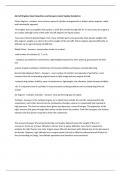Aircraft Engines Exam Questions and Answers Latest Update Graded A+
Piston Engines - Answers -two common types of cylinder arrangements in today's piston engines: radial
and horizontally opposed.
-The engine turns a propeller that pushes or pulls the aircraft through the air. In most cases the engine is
air cooled, although some of the older aircraft engines are liquid cooled.
-have two inherent disadvantages: their many complex parts and, generally, their greater weight ratio
(the engine's weight as a ratio to the entire weight of the aircraft). Piston engines operate efficiently at
altitudes up to approximately 12,000 feet.
Radial Piston - Answers -construction similar to a wheel
-odd number of cylinders (5, 7, or 9)
- compact, accessible for maintenence, lightweight(compared to other pistons), good power for their
size
-poorly shaped resulting in interference to forward visibility and imposes considerable drag
Horizontally Opposed Piston - Answers - even number of cylinders set opposite of eachother, most
common form of reciprocating engine found on light sinlge and twin engine aircraft
-reduced drag, better visibility, ease of maintenence, lightweight, low vibration, better forward visibility
-dis- if using more than 6 cyclinders it may encounter cooling problems and increased drag from air
scoops
Jet Engines - turbojet, turbofan - Answers -best performing type of engine
Turbojet - Answers In the turbojet engine, air is taken from outside the aircraft, compressed by the
compressor, and is then forced into the combustion chamber, where it is mixed with fuel injected at
high pressure. This fuel-air mixture then ignites and becomes a mass of hot gas. The expansion of the
high- pressure hot gases through the turbine nozzles drives the turbine. From the hot gases, the turbine
extracts only that power required to drive the compressor.
The amount of power (thrust) generated by a jet engine depends upon the weight of the air it
consumes. As the air at lower altitudes is denser than at upper altitudes, more fuel is required to
produce the right fuel-air mix ratio. Engine power (thrust) decreases with altitude due to the decrease in
air density. However, high altitude loss in engine power (thrust) is offset by reduced aircraft friction to
the surrounding air (drag). Low altitude operations are therefore not economical.
, The advantages of the turbojet engine are few moving and intricate parts, good power to weight ratio,
reduced drag from small frontal area (and no propeller). However, turbojets consume excessive
amounts of fuel at low altitudes, and are slow to respond to application of power. Examples of aircraft
equipped with turbojet engines are L29A (Jetstar), DC8, B707/C135 (pictured at right), and most military
jet fighters.
Best Performance for a Turbojet - Answers ATS personnel endeavor to ensure that these types of aircraft
spend the least amount of time possible at lower altitudes. When turbojets operate at lower altitudes,
their fuel consumption in gallons per hour is high and engine efficiency in terms of miles per gallon is
poor. Turbojet engines are designed for high speed, high altitude operations and their efficiency
increases as altitude increases, reaching maximum efficiency at approximately 36,000 feet (varies with
the type of jet engine).
Turbofan - Answers The turbofan is a "new and improved" version of the turbojet engine, which has a
fan attached ahead of the compressor that accelerates air backwards and bypasses the core of the
engine or behind the turbines. The outside diameter of the fan is greater than that of the engine proper
so that the air, passing through the blades at their outer part, is accelerated backwards on the outside of
the engine. This extra power (thrust) is available for increased take-off, climb and cruise performance,
reduced fuel consumption and hence, better payload/range.
This type of engine is designed for high speed, high altitude operations. Efficiency improves as the
altitude increases, reaching optimum efficiency at between 33,000 and 37,000 feet. Jet engines
operating at low altitudes burn a great deal of fuel and pilots spend as short a period of time as possible,
taxiing and at low altitudes because of high fuel burn. Turbofan engines have several advantages over
turbojet engines, including greater fuel efficiency, quieter operation, better low altitude performance,
and lower landing speeds.
However, compared to the piston they also have high fuel consumption at low altitudes. This type of
engine is found on most of today's commercial and executive jets. Examples of aircraft equipped with
turbofan engines include: Airbus 320, C550 (Citation Two), and B767.
Turboprop - Answers combines the properties of the propeller and the jet engine. The gas turbine
engine can be used to drive a propeller instead of producing pure jet power (thrust). Turbines
constructed to drive propellers are called turboprop engines.
In the turboprop engine, the energy of the heated gases is almost completely expended in the turbine,
leaving only a small amount of velocity energy to produce power (thrust) when ejected from the exhaust
nozzle. Only the energy absorbed by the turbine that is in excess of that required to drive the propeller




